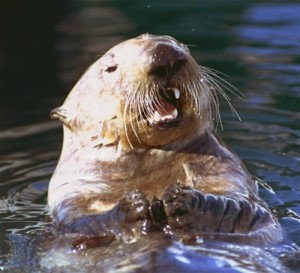Scientists wanting to know what sea otters eat while floating far from shore have turned to the sky. During an April mission in Kachemak Bay, researchers tested unmanned drones to see if they could be used for future sea otter surveys. The project also used drones to study the prevalence of sea grass in intertidal flats.
Using drones for the intertidal flats mission was mostly to streamline the process, allowing a larger area to be surveyed in a shorter amount of time.
When it comes to otters, scientists want to know what the predators regularly eat to better understand how it may affect fisheries management. Current observation techniques are restricted to watching sea otters with high-powered spotting scopes. The practice is only viable on land, as swells and turbulent boats make scopes unfeasible.
Close to shore, otters eat clams, crab, octopus, fish and the occasional sea urchin or star fish. But in open water, scientists “have no idea what they’re feeding on,” Brenda Konar, professor of marine biology at the University of Alaska Fairbanks, said.
During the project, most drone flights were conducted from land so researchers could use spotting scopes to see if otters avoided the drones.
According to Konar, the project was “really successful,” even without recording new feeding data. “At this point, all we did with them was to see how close we can get to them and see if the would try to freak out or not.”
Konar said drones were able to be flown within about 10 feet of the otters, and most animals paid the quadcopters no attention.
Kachemak Bay’s otter population is doing better than most around Alaska, Konar said. That is in contrast to the Bay’s crab population. “They’re not coming back the way people are hoping,” Konar said of crabs. Konar hopes drones can help determine if otters’ fishing habits contribute to low crab numbers.
Team members learned both from successes and challenges during the mission.
Sam Vanderwaal, project manager and drone pilot, said tricky technical issues arose. Maintaining connectivity with drones was problematic while trying to catch otters in the bay. Common issues — like recharging batteries in the field and keeping equipment dry — also popped up.
Vanderwaal is an embedded contractor at the Alaska Center for Unmanned Aircraft Systems Integration at UAF’s Geophysical Institute. The Center for Unmanned Aircraft has a certificate of authorization from the Federal Aviation Administration to operate drones professionally.
The GoPro cameras equipped on the drones also lacked sufficient resolution for the tidal flats survey. A better camera would require drones with larger payloads.
When it came to otters, simple techniques were practiced to get drones as close as possible. As otters dove to find food drone operators would lower the aircraft for when the animal resurfaced. “We learned if you did it in steps the otter didn’t seem to care,” Konar said.
Konar is working to procure funding for the next mission, when she would like to get some actual feeding data.
Source: newsminer.com

